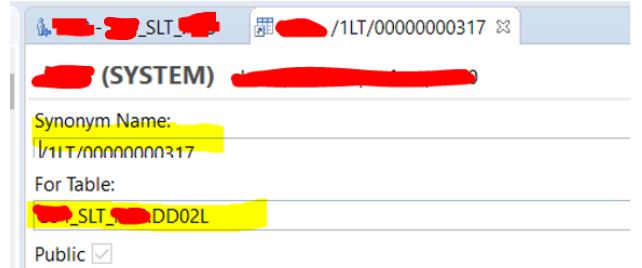
#ATR(5)
Informative Note – Created this blog to provide information on how SLT works in backend.
Prerequisites: Knowledge on SLT Configuration, RFC.
Most of the basis peoples know about SLT configuration. But it’s difficult to track how data being sent from source to target system if any issues occurred. Below information might help a lot to resolve those issues.
Mainly, Duplicate Logging tables and Public Synonyms – Insertion of structure /1CADMC/*** into data dictionary failed.
IN GENERAL – How SLT works?
Consider we have created new SLT configuration. By default, SAP Standard tables (DD02L, DD02T, DD08L) would have transferred automatically once SLT created. I have deleted those tables and added manually just to show process. DD02L table taken for example.
Source: S/4 HANA OR ABAP ERP System (Having DMIS Add on) — No Separate LT server.
Target: Standalone HANA Database System – Tables can be seen via HANA Studio/Cockpit as usual.
Tables yet to be replicated.
STEP 1: CREATE TABLE/VIEW
Provide table names and select create Table/DB view.

You can see proxy table /ILT/00000*(In Source System), Public Synonyms (In Target System as same as proxy table name) and tables (In Target System) were created successfully.
Source ABAP LTRC:

Target System HANA DB:

Each Public Synonym will have a link to created target table data. This will help to transfer data to right target table.

My Scenario: Proxy table will be created in Source System itself since DMIS add on component installed in Source system. We don’t have separate LT server. Since it’s LT database tables and not resides in Source system technically, we will get “Database not exists” error but data can be viewed after error.

NOTE:
DD02L, DD02T and DD08L – SAP Standard tables which needs to be replicated first before other tables (MARA, MBEW, etc.,).
STEP 2: START LOAD
Once initial load completed, Data will be transferred from source to target table.


Load operation: Source table -> Stores data in LT Proxy table /LT/0000* -> Send data to Target System by using RFC -> Target system checks Public Synonym name (which will be same as LT Proxy table Name) to identify target table -> Stores data in Target table.
Meanwhile, Logging table will be created in Source System – For triggering operations (initial load)
Each logging table will be synced to */LT* (proxy) corresponding table.

STEP 3: START REPLICATION
Start replication to replicate real time data from source to target. It will use data transfer jobs to transfer data.

You can see progress in Data Transfer Monitor.

Table Entries count check:

INFO:
Error: Duplicate Logging tables and Public Synonyms – Insertion of structure /1CADMC/*** into data dictionary failed.
DD02L Table Name – SAP Tables
Taking DD02L for example.
If one logging table, proxy table and public synonym resides for DD02L without duplicate, it will use that tables for replication purposes.
If NIL for DD02L, it will create new tables and proceed for next load steps and replication.
If duplicate(more than one) logging tables, proxy table and public synonym resides, SLT collapse and fails with this error. You can see multiple duplicate tables exist for DD02L.


/1LT 201,205,211 had link to DD02L same table.

Steps to resolve issue:
- Stop Load/Replication for LTRC replicated tables.
- Deactivate configuration
- Reset – Tables and Synonyms, Triggers and Logging tables in LTRC.
- Delete duplicate logging (CADMC*) and Proxy tables (/1LT*) in Source System (Via SE11 transaction) – Requires Developer and Object key for deletion.
- Delete duplicate public synonyms in Target System and replicated tables in target system. (You can find relevant information by tracking table data with above information.)
- Reactivate Configuration.
Thanks for visiting !
如有侵权请联系:admin#unsafe.sh